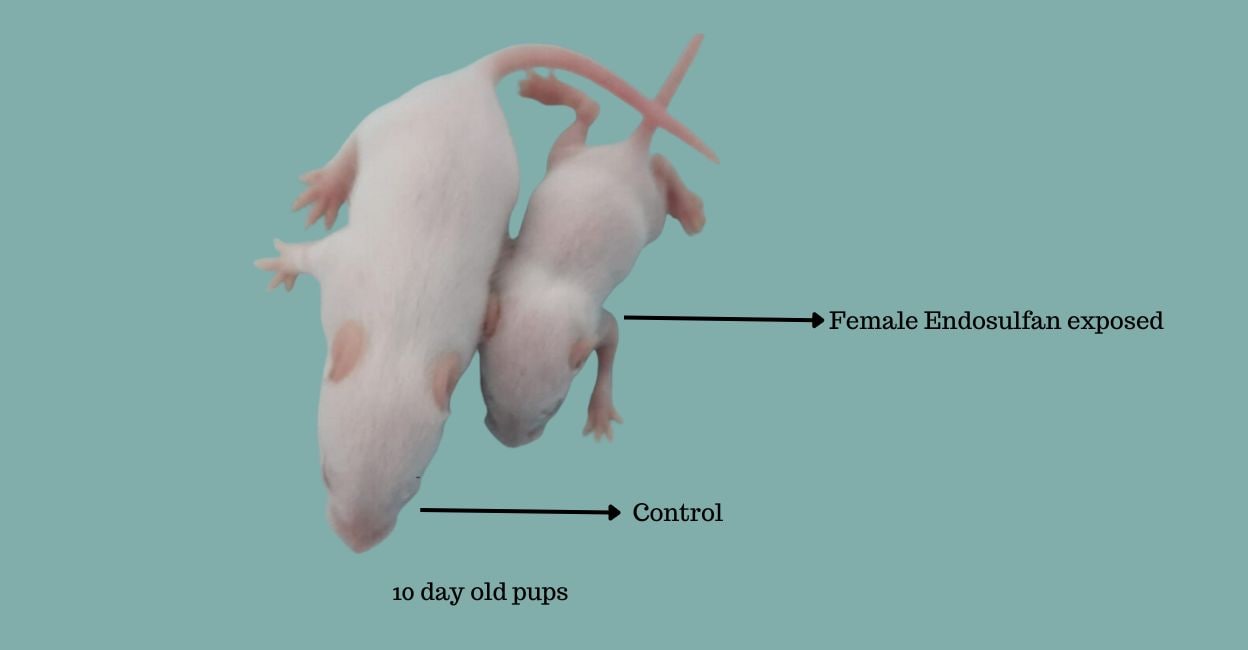IISc research punctures Kerala govt's endosulfan order, finds genetic mutation in unexposed next generation

Mail This Article
Kasaragod: In a study that would expose the flaw in the Kerala government's methodology to identify endosulfan victims, researchers at the Indian Institute of Science (IISc), Bengaluru, found that offspring of mice exposed to endosulfan could be born with defective DNA, organ damages and physical deformities.
These genetic defects might get transferred to the next generation even if one of the parents was exposed to the highly toxic pesticide, found the study led by Prof Sathees C Raghavan of the Department of Biochemistry at IISc.
But the government of Kerala, in November 2023, brought out an order that limited the impact of two decades of aerial spraying of endosulfan to its "persistence in the environment", ignoring the long-term and long-lasting genetic damage the pesticide can trigger in humans.
The order brought out to identify endosulfan victims said endosulfan could persist in the environment for a maximum possible duration of six years.
Considering endosulfan was banned through a Gazette notification on October 25, 2005, the maximum possible environmental persistence will be up to October 25, 2011, it said. "So anyone who lived in these places or had intrauterine exposure from Jan 1980 till October 2011 is defined as 'exposed'," the order said.
Since the intrauterine period means the time between conception and birth, the state government will not consider a child conceived after October 2011 as endosulfan-affected.
"More research has to be done but our findings could argue against the government order," said Prof Raghavan, the recipient of the Shanti Swarup Bhatnagar Prize, the highest science award in India, in 2013. Onmanorama caught up with him when he came to Kasaragod to present the findings at the 46th annual meeting of the Environmental Mutagen Society of India at the Central University of Kerala.
'Underdeveloped eyes, underweight, damaged organs...'

The two mice in the photograph above are not of a mother and her pup. Neither are they from two different generations or of different ages.
The two laboratory mice are 10 days old. The weakling on the right is a pup of an otherwise healthy mother that was exposed to endosulfan pesticide when it was four to eight weeks old (one to 15 years of human age). The mother conceived when it was 10 to 12 weeks old (comparable to 20 human years).
The healthy pup on the left -- that weighed double that on the right -- is an offspring of two mice unexposed to endosulfan, said Prof Raghavan.

His lab specialises in DNA damage and repair. For the past 14 years, his team has been researching the long-term and long-lasting effects of endosulfan on general biology and the reproductive system.
The study found that the unexposed offspring were born with damaged organs such as the liver and lungs, and had developmental defects. "Their (pups of exposed mice) size, movement, and memory were affected in several instances," Prof Raghavan told Onmanorama. "We observed similar levels of gene regulations in treated mice and in their unexposed progenies, which are being investigated further," he said. Gene regulation plays a role in processes such as DNA repair, growth, development, metabolism, and responding to external stimuli.
Prof Raghavan started his research with only male mice in 2010. He and Robin Sebastian, a researcher at his lab, found that the testes of mice treated with endosulfan considerably shrunk, the tubules that produced sperm were damaged and sperm count decreased. The findings were published in 'Cell Death and Discovery', a journal published by Nature Publishing Group, in 2015 and 'Carcinogenesis' by Oxford University Press in 2016. "But we did not find any developmental abnormality at that time," he said.
The tests were conducted by feeding the mice a sublethal dose of 3 mg per kg of endosulfan, which translated to 23 micrograms per litre in blood.
Anju Sharma from Prof Raghavan's team then redid the experiment on male and female mice after increasing the dose to 5 mg per kg (50 micrograms per litre). "Even that was low because the serum concentration of endosulfan was greater than 100 micrograms per litre in people living in endosulfan-affected areas in different parts of the world," he said.
The mice were fed endosulfan only for 10 alternate days. Even eight months after the endosulfan exposure (around 15 human years), IISc researchers found increased DNA breaks in reproductive tissues such as testes, ovaries, uterus, fallopian tubes, prostate gland, and epididymis -- the duct where sperm mature and are stored. A few treated mice developed tumors.
The researchers then put the exposed mice in three groups -- the first group had exposed male mice and unexposed female mice; the second group had exposed female mice and unexposed male mice; and the third group had exposed male and female mice. They also had a 'control' group where males and females were not exposed.

The infertility rate of only exposed male mice was 55%; that of only female mice was 62%; and where both male and female mice were exposed, the infertility rate was 67%.
The findings were published in 'Frontiers in Genetics', a peer-reviewed journal in November 2022.
Mice and rats are preferred species for biomedical research because of their anatomical, physiological, and genetic similarity to humans.
But Prof Raghavan's latest findings suggested that exposure to endosulfan affected even the unexposed next generation.
In plants, the genetic mutation and epigenetic changes triggered by pesticides are seen not only in the unexposed progeny but also in the unexposed third generation or grand progeny, said Dr Jasmine M Shah, Assistant Professor in the Department of Plant Science at the Central University of Kerala.
Her student Sijila J exposed 100 plus Arabidopsis thaliana -- a flowering plant in the mustard family -- to malathion, a pesticide that breaks down much faster in the environment than endosulfan. Their research found that exposure to malathion increased the frameshift mutation rates by 75% in the plant. "In the next unexposed generation, the frameshift mutation fell to 4%, and in the unexposed grand progeny, it further fell to 3%. But these rates are significantly higher than those from the grand progeny of untreated plants," Dr Shah said. Frameshift mutations can lead to the production of abnormal proteins in plants and animals, triggering significant consequences, she said.
The unexposed grand progeny also saw epigenetic changes in the genes that repair DNA. Unlike the permanent genetic changes, epimutations are changes outside the DNA but affect gene regulation. They may wear off in time, yet, these epimutations were seen in the unexposed second and third generations of the plants.
Dr Shah, who also presented her findings at the mutagen society's annual meeting, said environmental persistence was just one of the ways in which pesticides impacted biodiversity and human health. "The genetic mutations and epimutations triggered by pesticide transcend generations as seen in the recent results," she said. In the light of the recent studies, 'environmental persistence' should be redefined because a chemical's environmental persistence and the persistence of its impact are not the same, she said.


